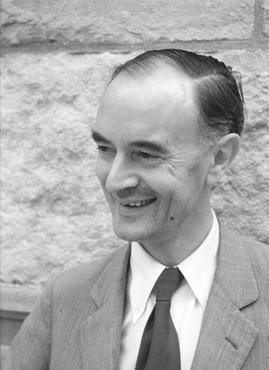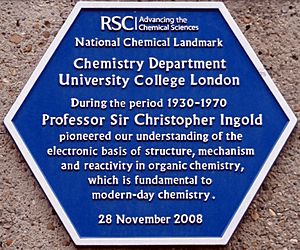Christopher Kelk Ingold facts for kids
Quick facts for kids
Sir
Christopher Kelk Ingold
|
|
|---|---|

Ingold, as photographed in Michigan State University.
|
|
| Born | 28 October 1893 London, United Kingdom
|
| Died | 8 December 1970 (aged 77) Edgware, London
|
| Nationality | British |
| Alma mater | Hartley University College (now University of Southampton) Imperial College London |
| Known for | Organic reaction mechanisms Cahn–Ingold–Prelog rules Hughes–Ingold rules Thorpe-Ingold effect |
| Awards |
|
| Scientific career | |
| Fields | Chemistry |
| Institutions | Imperial College London University of Leeds University College London |
| Thesis | Formation and stability of carbon rings (1921) |
| Academic advisors | Jocelyn Field Thorpe |
| Doctoral students | Ronald Gillespie Ronald Sydney Nyholm Peter de la Mare |
| Signature | |
Sir Christopher Kelk Ingold (born October 28, 1893 – died December 8, 1970) was a very important British chemist. He worked in Leeds and London.
In the 1920s and 1930s, he did amazing work on how chemical reactions happen. He also studied the structure of organic compounds. He helped introduce key ideas into chemistry. These ideas include nucleophiles and electrophiles, which are particles involved in reactions. He also explained inductive and resonance effects, which describe how electrons move in molecules.
Ingold also helped create terms like SN1, SN2, E1, and E2. These terms describe different types of chemical reactions. He also co-wrote the Cahn–Ingold–Prelog priority rules. These rules help chemists name and understand the 3D shapes of molecules. Many people see Ingold as a founder of physical organic chemistry. This field combines ideas from physical chemistry and organic chemistry.
Contents
Early Life and Education
Christopher Ingold was born in London. His father, a silk merchant, died when Christopher was only five years old.
Ingold started his science studies at Hartley University College in Southampton. This college is now called University of Southampton. He earned his first degree in 1913 from the University of London.
After that, he joined the lab of Jocelyn Field Thorpe at Imperial College, London. For a short time, from 1918 to 1920, he paused his studies. During this time, he did important research for national defense. This work involved studying chemicals and their production.
Ingold received another degree, an MSc, from the University of London. He then went back to Imperial College in 1920 to work with Professor Thorpe again. He earned his PhD in 1918 and a DSc in 1921.
Academic Career and Discoveries
In 1924, Ingold moved to the University of Leeds. He worked there for six years as a Professor of Organic Chemistry. In 1930, he returned to London. He became the head of the chemistry department at University College London. He led the department for 24 years, from 1937 until he retired in 1961.
During his research, Ingold studied a type of chemical called alkyl halides. He found that there were two main ways certain reactions could happen. These reactions are called nucleophilic substitution reactions.
He discovered that some alkyl halides react in two steps (called SN1 reactions). Other alkyl halides react in just one step (called SN2 reactions). He figured this out by looking at how fast the reactions happened. For example, some reactions only depended on how much alkyl halide was present. Others depended on both the alkyl halide and another chemical called a nucleophile.
Around 1926, Ingold had some strong scientific discussions with another chemist, Robert Robinson. They had different ideas about how electrons behave in organic reactions. Both of their ideas helped chemistry grow.
Ingold wrote or co-wrote a huge number of scientific papers, 443 in total! Some of his notable students include Peter de la Mare, Ronald Gillespie, and Ronald Nyholm.
Honours and Recognition
In 1920, Christopher Ingold received the British Empire Medal (BEM). He earned this award for his brave work during wartime research. He showed great courage in dangerous conditions and even risked his life to prevent serious accidents. However, he rarely spoke about this award or this time in his life.
In 1924, Ingold was chosen as a Fellow of the Royal Society (FRS). This is a very high honor for scientists in the UK. He also received the Longstaff Medal in 1951 from the Royal Society of Chemistry. In 1952, he was awarded the Royal Medal by the Royal Society.
In 1958, he was knighted, which means he was given the title "Sir."
Today, the chemistry department building at University College London is named after him. It's called the Sir Christopher Ingold building and opened in 1969.
Personal Life
In 1923, Ingold married Dr. Hilda Usherwood. She was also a chemist and they often worked together on research. They had two daughters and a son. Their son, Keith Ingold, also became a well-known chemist.
Death
Sir Christopher Ingold passed away in London in 1970. He was 77 years old.


